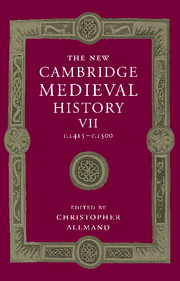Book contents
- Frontmatter
- PART I GOVERNMENT
- PART II ECONOMIC AND SOCIAL DEVELOPMENTS
- 4 The European Nobility
- 5 Rural Europe
- 6 Urban Europe
- 7 Commerce and Trade
- 8 War
- 9 Exploration and Discovery
- PART III SPIRITUAL, CULTURAL AND ARTISTIC LIFE
- PART IV THE DEVELOPMENT OF EUROPEAN STATES
- Appendix Genealogical Tables
- Primary Sources and Secondary Works Arranged by Chapter
- Index
- Frontispiece
- Plate section
- Map 1 European towns in the late Middle Ages
- Map 2 European commerce and trade
- Map 4 Winds and currents facilitating the discoveries
- Map 5 The universities o f Europe in 1400 and 1500
- Map 6 Germany and the Empire
- Map 20 The Roman Orthodox and Ottoman worlds in the fifteenth century
- References
4 - The European Nobility
from PART II - ECONOMIC AND SOCIAL DEVELOPMENTS
Published online by Cambridge University Press: 28 March 2008
- Frontmatter
- PART I GOVERNMENT
- PART II ECONOMIC AND SOCIAL DEVELOPMENTS
- 4 The European Nobility
- 5 Rural Europe
- 6 Urban Europe
- 7 Commerce and Trade
- 8 War
- 9 Exploration and Discovery
- PART III SPIRITUAL, CULTURAL AND ARTISTIC LIFE
- PART IV THE DEVELOPMENT OF EUROPEAN STATES
- Appendix Genealogical Tables
- Primary Sources and Secondary Works Arranged by Chapter
- Index
- Frontispiece
- Plate section
- Map 1 European towns in the late Middle Ages
- Map 2 European commerce and trade
- Map 4 Winds and currents facilitating the discoveries
- Map 5 The universities o f Europe in 1400 and 1500
- Map 6 Germany and the Empire
- Map 20 The Roman Orthodox and Ottoman worlds in the fifteenth century
- References
Summary
more than any other social class or grouping (including the ecclesiastical one), the nobility of Europe at the end of the Middle Ages needs and deserves to be studied from a standpoint that is not merely socio-economic, but political and cultural, too. In this chapter Europe is deemed synonymous with Latin Christendom. None the less, this does not imply the assumption that contemporaries believed nobility to exist only within Latin Christendom. As proof of this, armorials compiled in France and elsewhere included, for example, the arms of the Grand Khan, the sultan of Babylon, the Grand Turk, and the king of Granada (these next to the arms of the Christian king of Armenia), while an author like Gilles le Bouvier, in his Livre de la description des pays (c. 1450), could refer in particular to the Turkish nobility. To a certain extent, then, the inhabitants of fifteenth-century Christendom regarded nobility as a universal social order.
Since there was not merely one European society, but many, each with its individual characteristics, the present approach must be comparative. In view of the enormous diversity among these societies, it is pertinent to ask whether comparisons are feasible and, above all, useful, enlightening and convincing. However, whereas doubts about the validity of this kind of approach may be understandable in the case of the peasantry (for example), the case of the nobility is different. For a start, then, two questions will be asked. Was there a European nobility? And, secondly, was there a European concept of that nobility?
Keywords
- Type
- Chapter
- Information
- The New Cambridge Medieval History , pp. 87 - 105Publisher: Cambridge University PressPrint publication year: 1998
References
- 1
- Cited by



